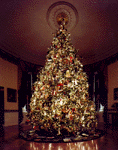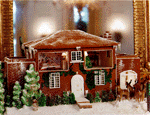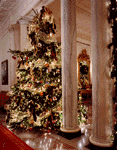

Reading the poem aloud on Christmas Eve is one of the season's most cherished rituals, not only for the First Family, but for families in all parts of our nation.
So, in honor of families everywhere, the 1995 holiday decorations at the White House celebrate the story of "The Night Before Christmas" with all its humor and warmth.
This year, the First Family invited three distinct groups of artisans to created ornaments for the White House trees. The American Institute of Architects and architecture students designed ornaments representing the house that is the scene of Santa's visit. Culinary schools sent ornaments of confectionary delights, inspired by "visions of sugar plums," while the American Needlepoint Guild and the Embroiderers Guild of America created the traditional holiday stockings.
As always, each ornament is a delightful reminder of the variety of American talent and imagination.
As you enter the White House through the EAST WING entrance, you are greeted by the first of our special holiday trees, which stands in the EAST GARDEN ROOM. The tree is decorated with a sampling of the handmade angel ornaments created by American craftspeople, and used during December 1993.
Just outside the EAST COLONNADE, where oversized wreaths of lush greenery are hung in each window, is the Jacqueline Kennedy Garden, where an exhibit of twentieth century American sculpture is on view. At the end of the colonnade is the EAST FOYER, where you will find the tree decorated whit ornaments from December 1994. The theme was "The Twelve Days of Christmas," and the ornaments were submitted by art and design schools from across the country, as well as the National Society of Tole and Decorative Painters.
Also in the East Foyer is the retrospective exhibit of White House Christmas cards dating back to the Eisenhower Administration. The official card for 1995 depicts the recently refurbished Blue Room, and the original painting by Thomas McKnight entitled "White House Blue Room."
The GROUND FLOOR CORRIDOR is festooned with holiday greenery and ribbons. Red and gold bows tied to the chandeliers continue the traditional holiday theme.
To the left is the DIPLOMATIC RECEPTION ROOM where visiting dignitaries are welcomed. On either side of the fireplace stand two trees decorated with ornaments from the Department of Education's Blue Ribbon Schools. Each school contributed eight ornaments, reflecting their interpretations of the Clement C. Moore poem. The Blue Ribbon Schools Program recognizes and supports primary and secondary schools that are noted for their exceptional arts education, and their effectiveness in meeting the national education goals.
In the EAST ROOM, the traditional White House creche is the focal point. This exquisite antique creche was made in Naples, Italy in the late eighteenth century, and features 47 carved wood and terra cotta figures. The creche was a gift to the White House from Mrs. Charles Engelhard, Jr. of Far Hills, New Jersey, and has been displayed each year since it was presented in 1967.
Six lofty trees, ranging from 12 feet to 20 feet, and ornamented with burgundy and gold ribbons, are stationed alongside the creche, at the center windows, and flanking the hallway entrance. Mixed greenery and hurricane candles decorate the mantels of the four fireplaces, and musical groups from across the country fill the room with the sounds of the holidays.
The GREEN ROOM is used as a parlor for small teas and receptions. Above the fireplace hangs the renowned portrait of Benjamin Franklin by David Martin. Holiday topiaries are festooned with greens and mauve flowers. The mantel is decorated with a townscape created by twenty architects from Community Design Services, through which architects and other design professionals volunteer their time to provide design and architecture services to non-profit community organizations.
 The official White House tree, as always, stands in the BLUE ROOM. This
year, it is an 18-1/2 foot Fraser fir from Atwood Dollar Hudler Tree Farms
near West Jefferson, North Carolina. The tree was presented to the
President and Mrs. Clinton by Ronald Hudler and Daniel Dollar who won the
honor by being named 1995 National Grand Champion Growers by the National
Christmas Tree Association. The tree is decorated by the American
The official White House tree, as always, stands in the BLUE ROOM. This
year, it is an 18-1/2 foot Fraser fir from Atwood Dollar Hudler Tree Farms
near West Jefferson, North Carolina. The tree was presented to the
President and Mrs. Clinton by Ronald Hudler and Daniel Dollar who won the
honor by being named 1995 National Grand Champion Growers by the National
Christmas Tree Association. The tree is decorated by the American
 Institute of Architects and architecture students whose ornaments were
inspired by the lines, "'Twas the night before Christmas, and all through
the house..." Chimneys, windows, rooftops, shutters, and porches - all
bedecked for the holidays - can be seen on the tree. Also featured on
the Blue Room tree are the magnificent stockings created by the
Embroiderers Guild of America and the American Needlepoint Guild. The
green velvet hand-made skirt was designed by individual artisans from each
of the 50 states, territories and the District of Columbia, to celebrate
the first Clinton holidays at the White House.
Institute of Architects and architecture students whose ornaments were
inspired by the lines, "'Twas the night before Christmas, and all through
the house..." Chimneys, windows, rooftops, shutters, and porches - all
bedecked for the holidays - can be seen on the tree. Also featured on
the Blue Room tree are the magnificent stockings created by the
Embroiderers Guild of America and the American Needlepoint Guild. The
green velvet hand-made skirt was designed by individual artisans from each
of the 50 states, territories and the District of Columbia, to celebrate
the first Clinton holidays at the White House.
The RED ROOM, furnished in classic American Empire style, is decorated with holly and greenery that reflects the spirit of the season. The mantel displays an architectural study inspired by the poem, and designed by the 6th graders of John Eaton Elementary School in Washington, D.C. with the help of Architecture in the Schools, which brings architects and college-level architecture students into Washington-area classrooms.
 Heads of state, foreign dignitaries, and guests from across the United
States are entertained in the elegant STATE DINING ROOM, where the famous
George P.A. Healy portrait of Abraham Lincoln hangs above the mantel.
Mixed greenery, along with burgundy and gold ribbons, drape the mantel
and decorate the sconces to create a festive mood.
Heads of state, foreign dignitaries, and guests from across the United
States are entertained in the elegant STATE DINING ROOM, where the famous
George P.A. Healy portrait of Abraham Lincoln hangs above the mantel.
Mixed greenery, along with burgundy and gold ribbons, drape the mantel
and decorate the sconces to create a festive mood.
 The showcase piece in the State Dining Room is always the traditional
gingerbread house created by the White House Pastry Chef. This year, the
house is a sentimental favorite of the First Lady, as it is a replica of
her girlhood home on Wisner Street in Park Ridge, Illinois. The two
front rooms are done as they would appear in "The Night Before
Christmas:" the bedroom is filled with children "all snug in their beds,"
and the living room is complete with "stockings hung by the chimney with
care." The gingerbread house took nearly five months to create... and of
course, the entire creation is edible.
The showcase piece in the State Dining Room is always the traditional
gingerbread house created by the White House Pastry Chef. This year, the
house is a sentimental favorite of the First Lady, as it is a replica of
her girlhood home on Wisner Street in Park Ridge, Illinois. The two
front rooms are done as they would appear in "The Night Before
Christmas:" the bedroom is filled with children "all snug in their beds,"
and the living room is complete with "stockings hung by the chimney with
care." The gingerbread house took nearly five months to create... and of
course, the entire creation is edible.
 The four large trees that flank the front door and stand between the
columns in the GRAND FOYER have a special theme all their own. Decorated
by chefs from cooking schools across the country, they are edible
examples of the line, "while visions of sugar plums danced in their
heads." With marzipan, gingerbread, cookie dough, pastillage and
chocolate, these culinary artists created some of this year's most
imaginative ornaments.
The four large trees that flank the front door and stand between the
columns in the GRAND FOYER have a special theme all their own. Decorated
by chefs from cooking schools across the country, they are edible
examples of the line, "while visions of sugar plums danced in their
heads." With marzipan, gingerbread, cookie dough, pastillage and
chocolate, these culinary artists created some of this year's most
imaginative ornaments.
Also in the Grand Foyer, you will see the needlepoint "kissing ball" made by master needlepoint artist, Hyla Hurley of Washington, D.C. It is a miniature version of the tapestry which hangs in the First Family residence, and depicts the road to the White House, from the Governor's Mansion in Little Rock, via Monticello and a place called Hope.